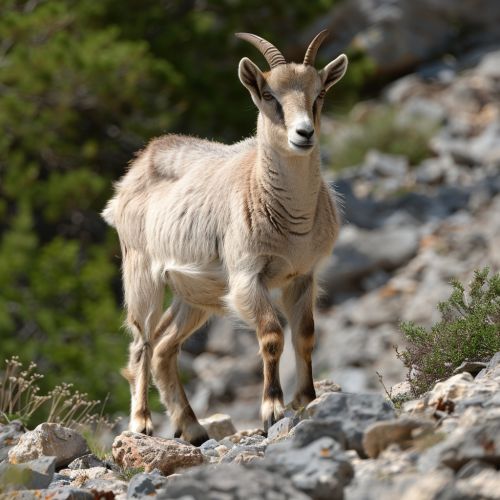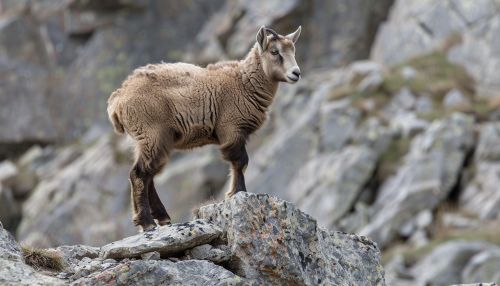Capra pyrenaica
Capra pyrenaica


Capra pyrenaica, commonly known as the Iberian ibex, is a species of wild goat that is native to the Iberian Peninsula. This species is known for its impressive horns and its ability to navigate the rugged mountainous terrain of its habitat. The Iberian ibex is an important species for understanding the biodiversity and ecological dynamics of the Iberian Peninsula.
Taxonomy and Evolution
The Iberian ibex belongs to the genus Capra within the family Bovidae. It is closely related to other species of wild goats, such as the Alpine ibex (Capra ibex) and the Nubian ibex (Capra nubiana). The species was first described by the French naturalist Henri Marie Ducrotay de Blainville in 1845.
The evolutionary history of Capra pyrenaica is complex and involves multiple instances of speciation and hybridization. Genetic studies have shown that the Iberian ibex diverged from its closest relatives approximately 2 million years ago during the Pleistocene epoch. This divergence was likely driven by climatic changes and geographical barriers that isolated populations and led to the development of distinct genetic lineages.
Subspecies
There are four recognized subspecies of Capra pyrenaica:
- Capra pyrenaica pyrenaica: This subspecies, also known as the Pyrenean ibex, was native to the Pyrenees but was declared extinct in 2000.
- Capra pyrenaica hispanica: Commonly known as the Spanish ibex, this subspecies is found in the mountains of southern Spain.
- Capra pyrenaica lusitanica: This subspecies, known as the Portuguese ibex, was native to Portugal and became extinct in the 19th century.
- Capra pyrenaica victoriae: Found in the central mountains of Spain, this subspecies is named after Queen Victoria of Spain.
Physical Characteristics
The Iberian ibex is a medium-sized goat with a robust body and strong legs adapted for climbing rocky terrain. Males are significantly larger than females and possess large, curved horns that can grow up to 75 cm in length. These horns are used in dominance displays and combat during the mating season. Females have smaller, thinner horns.
The coat of the Iberian ibex is typically a light brown or gray color, which provides camouflage against the rocky landscape. During the winter months, the coat becomes thicker and darker to provide insulation against the cold.
Habitat and Distribution
The Iberian ibex inhabits mountainous regions with rocky outcrops and sparse vegetation. It is found at elevations ranging from 500 to 3,000 meters above sea level. The species is well-adapted to the harsh conditions of its habitat, including steep slopes and limited water sources.
The current distribution of Capra pyrenaica is limited to the Iberian Peninsula, with populations found in the Sierra Nevada, Sierra de Gredos, and other mountain ranges in Spain. Conservation efforts have been implemented to protect and manage these populations, including habitat restoration and anti-poaching measures.
Behavior and Ecology
The Iberian ibex is a social species that forms groups known as herds. These herds are typically composed of females and their offspring, while males tend to be solitary or form bachelor groups outside of the breeding season. The social structure of the herds is matriarchal, with older females leading the group.
The species is primarily diurnal, with peak activity occurring during the early morning and late afternoon. The Iberian ibex is an herbivore, feeding on a variety of grasses, shrubs, and other vegetation. Its diet varies seasonally, with a preference for high-nutrient plants during the spring and summer months.
Reproduction
The breeding season for the Iberian ibex occurs in the late autumn and early winter. During this time, males compete for access to females through displays of strength and combat. Dominant males establish territories and guard harems of females.
Gestation lasts approximately 165 days, with females giving birth to one or two offspring in the spring. The young are precocial and are able to follow their mothers shortly after birth. Weaning occurs at around six months of age, although the young may remain with their mothers for up to a year.
Conservation Status
The conservation status of Capra pyrenaica varies by subspecies. The Pyrenean ibex (Capra pyrenaica pyrenaica) was declared extinct in 2000, although efforts have been made to clone the species using preserved genetic material. The other subspecies are currently classified as Least Concern by the International Union for Conservation of Nature (IUCN), although they face threats from habitat loss, poaching, and disease.
Conservation efforts for the Iberian ibex include habitat protection, population monitoring, and the establishment of protected areas. These measures have been successful in stabilizing and increasing some populations, although continued vigilance is necessary to ensure the long-term survival of the species.
